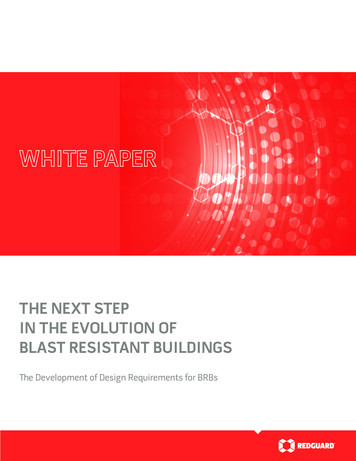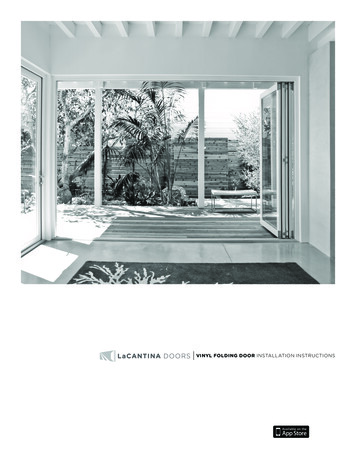
Transcription
THE NEXT STEPIN THE EVOLUTION OFBLAST RESISTANT BUILDINGSThe Development of Design Requirements for BRBs
The Blast Resistant Building (BRB) industry continues to strive to provide theultimate in protection for workers, their companies, and their communities. Thisemerging industry has made great advancements in understanding the anatomyof a blast which has improved the design and performance of BRBs. But, as theindustry continues to progress, it is now time to define the design requirementsnecessary to ensure that these technological and scientific advancements areput to use and that the buildings on-site meet a series of uniform guidelines. Tothat end this paper will explore the need for clear, concise design requirementsin the following areas: implementation of a classification/rating system, acceptance of low and medium building response levels only, required blast testing,certification of engineers and testing facilities, and the use of approved qualitymanagement systems and manufacturing processes.THE NEXT STEP IN THE EVOLUTION OF BLAST RESISTANT BUILDINGSpage2
There will always be inherent dangers associated with the refining of petroleumproducts and the manufacture of certain chemical compounds. One of the mostdevastating of these dangers is the ever-present risk of explosions within thesefacilities. Many consider the explosion in BP’s Texas City refinery in 2005, whichresulted in the death of 15 and injury to more than 180 others, to be a majorturning point in the adoption of new and additional safety processes and procedures. Even with an increased focus on Process Safety Management (PSM) in theyears since the Texas City disaster, the risk of explosions remains. In 2013, explosions in places such as Geismar, LA; West, TX; Pascagoula, MS; Alsip, IL; andDonaldsville, LA accounted for the deaths of 19 people and injury to 285 others.Unfortunately, these dangers cannot be completely regulated out of the industrynor can companies re-engineer the volatile reactions out of the processes completely. As such, mitigation of these risks becomes a primary means to reachingthe overriding objective, which is to increase safety in oil, gas, or petrochemical(OGP) facilities.The process of mitigating these risks has taken many shapes and involved anumber of agencies and industry groups over the years. Many improvementshave been made to the processes and new requirements have been added toincrease the level of protection afforded to the workers in OGP facilities. Evenwith this increased focus on PSM the use of blast resistant buildings is recommended within these facilities. The use of BRBs within OGP facilities improvedsignificantly due to the publication by the American Petroleum Institute (API)of Recommended Practice (RP) 752 and 753. RP 752 covers the management ofZONE 3Unrestricteduse ofportable trailers.ZONE 1Occupied lightwood buildingsnot allowed.CV1CV3CV2ZONE 2Location ofportable buildingsrequires detailedanalysis.THE NEXT STEP IN THE EVOLUTION OF BLAST RESISTANT BUILDINGSpage3
!WARNINGBLAST RESISTANT STRUCTURES REQUIREDhazards associated with the location of process plant permanent buildings. RP753 covers the same topic but for portable buildings. Prior to the issuance of RP753 many of the portable facilities used within a refinery or other OGP plantswere light wood trailers. The implementation of RP 753 was a great step inensuring additional safety by requiring that these light wood trailers be movedoutside of the blast zones at the facility and that the only occupied buildingswithin these dangerous zones are BRBs. The publication of RP 752 and RP 753greatly improved worker safety and created a new industry to supply these buildings to owners and contractors operating within the volatile facilities. However,as with any new advancement in technology, the initial solution needs to becontinually evaluated and modified as the technology and understanding of theblast science evolves to ensure that the greatest level of protection is affordedto the workers, companies, and their communities.“The primary objectivesfor providing blastresistant design inbuildings are:personnel safety;controlled shutdown; andfinancial consideration.”American Society ofCivil Engineers (ASCE)In the American Society of Civil Engineers (ASCE) publication, Design ofBlast-Resistant Buildings in Petrochemical Facilities, it states, “The primary objectives for providing blast resistant design in buildings are: personnel safety;controlled shutdown; and financial consideration.” In studying the topic ofblast resistant buildings for use in an OGP facility there are a large number ofbooks, papers and publications including RP 752 and RP 753, which advise theuse of blast resistant buildings. However, there is no document which defineswhat characteristics and practices are necessary to clearly ensure a blast resistant building provides the most suitable level of protection in a given scenarioin order to best meet those three primary objectives. These numerous documents provide a plethora of information pertaining to the siting, science, andTHE NEXT STEP IN THE EVOLUTION OF BLAST RESISTANT BUILDINGSpage4
mathematical equations behind the design of blast resistant buildings, but withthe volume of paper, hours of effort, and a proficient understanding of engineering needed to decipher all of this information, it still remains very difficult forthe end user to understand exactly what they need in a blast resistant buildingto best protect their personnel, their community and their company’s finances.With such large stakes, the industry needs a design requirement to ensure thatthe right building is built, with the right level of protection, and is in use in theright place should a blast event occur.To protect the occupants of the building, one must first understand what occursduring a blast event and the types of injuries that stakeholders are trying to prevent. There are several key factors which independently or jointly factor into whether or not an occupant survives and the types and severity of the injuries encountered. These key factors are best described as a response to the blast, and includeareas such as building response, human response, and nonstructural response.In the American Society of Civil Engineers (ASCE) publication, Design of Blast-Resistant Buildings in Petrochemical Facilities, a building’s response to a blast eventis categorized into one of three response levels. These response levels range fromlow response (low damage) to high response (catastrophic damage).In reviewing these definitions there are distinct differences between low, medium, and high response.RESPONSE LEVELSLOWRESPONSE(LOW DAMAGE)1) Localized building/component damage.2) Buildings can be used, however repairs are required to restorethe integrity of the structural envelope.3) The total cost of repair is moderate.MEDIUMRESPONSE1) Widespread building/component damage.2) Buildings cannot be used until repaired.3) The total cost of repair is significant.HIGHRESPONSE1) Building/component has lost structural integrity.2) Buildings may collapse due to the environmental conditions.3) The total cost of repairs approaches replacement cost of building.(MEDIUM DAMAGE)(HIGH DAMAGE)Table 5.B.1.A: Building Damage Levels as taken from Design of Blast-Resistant Buildings in Petrochemical Facilities by American Society of Chemical Engineers (ASCE), 2nd Edition, 2010.THE NEXT STEP IN THE EVOLUTION OF BLAST RESISTANT BUILDINGSpage5
50%PEAK PRESSURE (KILO LDLUN100500GINJURY50% EARDRUM RUPTUR100E10THRESHOLD EARDRUM10PEAK PRESSURE (PSI)10,000RUPTURE20.1110100POSITIVE PHASE DURATION (MILLISECONDS)1,000Courtesy of Bowen TE and Bellamy RF, eds, Emergency War Surgery.Washington, DC : United States Government Printing Office, 1988.The high response rating involves a loss of structural integrity , and representsthe beginning stages of collapse. Crush injuries and deaths caused by collapsedstructures falls under the quaternary blast injury category, which is one of fourcategories of blast injuries defined by medical professionals. The other three categories of blast injury include; primary, secondary, and tertiary. The human bodyhas been shown to be able to survive, although with considerable damage, theeffect of a 30 psi blast wave , however, the collapse of a building can ultimatelybring about loss of life in an otherwise survivable incident.Primary blast injuries are caused solely by the direct effect of blast overpressureas applied to the body’s tissues, or otherwise, human response. When the leadingedge of the blast wave reaches a person, it causes a large immediate increasein ambient pressure. Since explosive gases continue to expand from the originof the blast, a longer negative underpressure follows the positive overpressure.Both the positive overpressure and the negative underpressure can cause significant injuries, up to and including death. The most common injuries occur withinthe gas-containing organs due to the air contained within these organs beingcompressed by the pressures from the blast wave. The most susceptible organsinclude the lungs, gastrointestinal tract, and middle ear.One of the most widespread injuries associated with an explosion is eardrumdamage which can result in the loss of hearing and potentially render the victimdeaf. The eardrum will typically rupture when the overpressure exceeds 5 psi ,which is significantly less than the overpressures possible in many OGP facilities.Even when a worker is in a building, they are not saved from an increase in theoverall pressure changes caused by a blast event. The way a building reacts duringthe blast event is a significant factor in how those pressures are mitigated, or not,THE NEXT STEP IN THE EVOLUTION OF BLAST RESISTANT BUILDINGSpage6
even to those inside of a BRB. The pressure inside of a building can change significantlybased on building design and how much deflection occurs to the walls when impactedby the blast overpressure.When exposed to the higher overpressures possible in the OGP facilities, the eardrummay be destroyed and the ossicles, or bones of the inner ear, can be dislocated or fractured. Even explosions where overpressures have remained below 5 psi, the eardrumhas been shown to bleed even without fully rupturing.Pulmonary barotrauma is the most common cause of a fatal primary blast injury. Pulmonary barotrauma includes many associated injuries such as pulmonary contusion,systemic air embolism, thrombosis, lipoxygenation and disseminated intravascularcoagulation. This list of primary blast injuries is extensive and severe, but even ifthese injuries could be reduced to zero, the risk of injury or death during a blast doesnot disappear, as the leading cause of injury and death in a blast event is actually fromsecondary blast injuries.Secondary blast injuries are those injuries caused by debris propelled by the blastwave (nonstructural response) which results in both penetrating injuries and bluntforce trauma to the victim. A person who survives the initial blast wave can be killedor maimed by the flying debris. The chart below shows the low levels of weight, velocity and energy required for flying debris to critically injure specific body ERGY(FT-LB) 2.51040.180100.0014002.5 5.01090.17590.0015505 8.010120.1100160.0014503THORAXABDOMEN& LIMBSHEADFrom Table 1-3 of Threshold of Serious Injury to Personnel Due to Fragment Impact; Unified FacilitiesCriteria; UFC 3-340-02; Structures to Resist the Effects of Accidental Explosions; 5 December 2008This debris can be made up of any number of components occurring naturally andregularly within the refinery or petrochemical environment. It can be made up of metal shrapnel from the origin of the blast, glass from buildings and vehicles, and eveneveryday office equipment and supplies. For example, the glass façade on the AlfredP. Murrah Federal Building in Oklahoma City shattered into thousands of pieces whichTHE NEXT STEP IN THE EVOLUTION OF BLAST RESISTANT BUILDINGSpage7
were propelled throughout the building during that blast causing devastation tomany of the building occupants who had survived the initial explosion.The glass on a blast resistant building should be designed to withstand the blastwave and not shatter as the façade in Oklahoma City did. Nevertheless, coulda heavy operations binder on a shelf above a desk, or an unsecured desk, itself,cause injuries when propelled across a busy office? From the preceding chart, theanswer to that question is yes, since an object weighing only 0.1 lbs can cause asevere head injury when traveling at 100 fps. During a blast event, the walls ofa BRB will deflect, by design, to dissipate the forces being applied to the structure. When this occurs, the deflection can cause the outside wall to move severalinches which, in turn, can cause objects mounted to those walls, such as mirrors,shelves, and cubicles, to become projectiles.The primary reason for requiring the use of blast resistant buildings on an OGPfacility is to mitigate the potential risk of injury or death to the personnel onsite. But do all blast resistant buildings provide the same level of protectionfrom primary, secondary, tertiary and quaternary blast injuries? If not, how doesthe facility know that it has the right building, built right, with the right levelof protection, sitting in the right place should a blast occur? These questionspersist within this industry, and rightfully so, as the stakes could not be greaterto the personnel working at the facility, to the community in which the facility islocated, or to the financial wellbeing of the owner-operators.In many industries, when lives are on the line, and safety is paramount, thereare specific industry groups who have developed design requirements to includetesting, manufacturing and quality in order to ensure that all parties involvedhave a clear and uniform understanding of what the product can and cannot doto mitigate the potential for injury or death in their hazardous environment.Several examples exist, which show more mature industries progressing throughthe development of design requirements and practices. These guidelines, in turn,advance the industry and the level of safety and protection afforded to thosewho rely on these products to make it home each night. One good example ofthis is with ballistic body armor.In the mid-1970s, The National Institute of Justice (NIJ) began developingperformance requirements for body armor to help provide confidence to the lawenforcement community so that officers could consistently receive the protection they deserve each and every time they are faced with gunfire while on duty.Today, NIJ is tasked with researching, developing and maintaining the domesticTHE NEXT STEP IN THE EVOLUTION OF BLAST RESISTANT BUILDINGSpage8
standards for ballistic body armor. NIJ Standard-0101.06, “is a technical document that specifies the minimum performance requirements that equipmentmust meet to satisfy the requirements of criminal justice agencies and themethods that shall be used to test this performance. It can be used by bodyarmor manufacturers and purchasers to help determine whether specific modelsmeet the minimum performance standards and test methods identified”. Thisdesign guide was produced as part of their Standards and Testing Program.The NIJ Standard-0101.06 establishes a classification system to delineatethe varying levels of protection provided by different products or designs. Thispublished classification system allows a manufacturer or end user to know whatlevel of specific threat the body armor is designed and tested to withstand. If alaw enforcement officer determines that he needs protection from a .357 Magnum, then he can quickly determine that he needs a product that is certified atNIJ Level II. It does not matter which manufacturer is chosen or how a company’s marketing department has decided to advertise their product, NIJ Level IImeans that he is protected from a round from a .357 Magnum.In comparison, within the blast resistant building industry, there is no guidewhich can be used to determine precisely the level of protection provided by aparticular building. Site studies are performed at the OGP facility to determinethe threat level based on the specific processes occurring at that location. Oncethe threat level has been determined, it is then the end user’s responsibility tofind a building that protects occupants at that level, without the benefit of arating system as part of an overall design TIONNOMINALBULLET MASSMIN. REQUIREDBULLETVELOCITYNO. OFSHOTSNO. OFTESTS19MM FMJ8.0G 124GR373M/S (1225 FT/S)64240 S&W FMJ11.7G 180GR325M/S (1155 FT/S)6419MM FMJ8.0G 124GR398M/S (1305 FT/S)642357 MAG. JSP10.2G 124GR436M/S (1430 FT/S)641357 SIG FMJ FN8.1G 125GR448M/S (1470 FT/S)64244 MAG. SJHP15.6G 240GR436M/S (1430 FT/S)6417.62MM NATO FMJ9.6G 147GR847M/S (2780 FT/S)621.30 CAL M2 AP10.8G 166GR878M/S (2880 FT/S)12Table 4; P-BFS performance test summary; National Institute of Justice (NIJ)Standard 0101.06; Ballistic Resistance of Body Armor; July 2008THE NEXT STEP IN THE EVOLUTION OF BLAST RESISTANT BUILDINGSpage9
Most manufacturerscurrently use somesort of combination ofMost manufacturers currently use some sort of combination of pounds persquare inch (psi) measurement and a duration of time, expressed in milliseconds, (msec) in which that pressure is applied. But even if the language appearsto be similar from one manufacturer to the next, simple nuances exist which candrastically change the comparison. For instance, a blast resistant building canbe engineered to withstand a blast of 5 psi for 200 msec. That same buildingcould also be advertised to withstand a blast of 5 psi at 500 psi-msec whichcould also be a correct calculation. One description communicates the durationand the other the impulse, or measure of energy of the blast event (psi-msec),but to many in the OGP industry that difference is lost, and the 500 psi-msecimpulse appears to signify a more substantial building than the 200 msec duration rating even though both ratings can apply to the same building with theonly difference being what is calculated. This simple nuance can lead to confusion and possible acceptance of an inferior level of blast protection. The industrywould benefit greatly if a design guide were developed so that the manufacturer,owner-operators and end users all knew exactly what level of threat a buildingwas designed to withstand. By eliminating inconsistencies and providing thismuch-needed rating, the industry can make great strides to reduce the numberprimary and secondary blast injuries from occurring.pounds per square inch(psi) measurement anda duration of time,expressed in milliseconds,(msec) in which thatpressure is applied.The variation in building response levels, or the lack of understanding of theirmeaning, adds additional confusion surrounding the level of protection providedby a blast resistant building. As previously discussed, the differences betweenlow, medium, and high response can be extremely significant in the overall protection of personnel housed within a particular building. However, a building isdeemed to be “blast resistant” at all three levels.Continuing the comparison with the ballistic body armor industry, they haveaddressed a similar scenario in regards to backface deformation. Backface signature (BFS) or backface deformation is the term used to describe the transfer ofenergy from the bullet to the wearer of the body armor even when the bullet doesnot penetrate the body armor. This means that even though the vest stopped thebullet from penetrating the wearer’s body, the transfer of energy from that bulletis felt by the user of the vest. This backface deformation has been shown to causesevere injury due to the blunt force trauma as a result of the transfer of energy. Assuch, NIJ standards include testing for BFS and have established an upper limitas to the amount of impact allowable to meet the standard.In similar fashion, blast resistant buildings should have an upper limit on thebuilding’s intended response. Design requirements would help ensure that redundancy is engineered into the building and therefore the loss of structural integrity, or near collapse, is no longer a concern. If the overriding purpose of usingblast resistant buildings is personnel safety, controlled shutdown, and financialTHE NEXT STEP IN THE EVOLUTION OF BLAST RESISTANT BUILDINGSpage10
consideration, then allowing an occupied building to be designed to a highresponse level without the necessary redundancy should no longer be permitted.This one step could greatly reduce the number of quaternary injuries resultingfrom blasts in the refinery or petrochemical environment and save lives.Having both a classification system and an upper limit of the building’s responsewould be a great step forward in advancing this industry. But, to ensure that ablast resistant building meets the advertised and needed level of protection,testing would need to be required. Again, the ballistic body armor industry has already progressed through this stage. NIJ Standard-0101.06 includes an extensivetesting procedure to ensure that each product on the market meets the stringentrequirements necessary to protect human life.The NIJ specification includes the testing procedures for each level of classification as well as specifying the layout of the testing facility, the equipment to beused, how to properly measure and monitor the results, and even how to properlylabel a compliant product. For example, once the test range has been configuredas required in the standard, the testing on an NIJ Level II vest can begin. For thatvest to be certified it must be able to withstand, not just a single bullet from a .357Magnum, but each sample is tested to withstand 6 shots from a .357 Magnum at avelocity of 1340 ft/s /-30 ft/s and 6 shots from a 9mm at a velocity of 1245 ft/s /-30 ft/s. This type of detailed testing helps to ensure that if that product is everput to a real test that it will protect the user as stated.Testing products to this level of scrutiny within the blast resistant building industry is necessary given the impact an explosion could have on each of thestakeholders. The ability for the buyers and end users to know that the buildingsthey have in place are not only designed to withstand a particular size of blast,but have been proven to withstand it, goes a very long way toward protectinglives and communities. Performance of a blast test verifies a manufacturer’s basicdesign and permits that manufacturer to use proven values in their engineering onfuture projects. These measurements show exactly how a building will react duringa blast, including wall deflection and internal pressure measurements which arecrucial in preventing primary and secondary blast injuries to the occupants.As the blast protection industry continues to expand, more and more resources areput toward new developments and with that comes new knowledge and better understanding of how to offer greater levels of protection. But without a procedure inwhich to test these new discoveries, we have no way to know for certain that theseadvances are truly improving the resiliency of blast resistant buildings.THE NEXT STEP IN THE EVOLUTION OF BLAST RESISTANT BUILDINGSpage11
In addition to specifying the testing process for ballistic body armor, NIJ takesit a step further by requiring that laboratories performing ballistic testing areapproved through an accreditation process to meet specific technical requirements. This additional approval process provides real oversight to the testingprocess and is just one additional step to ensure that the results received aretrue and accurate.In the blast resistant building industry, the terms “designed” and “engineered”are used almost interchangeably to describe that the blast resistant building hasbeen reviewed by an engineer and found to have the ability to meet or exceedthe blast resistance requirements of a particular situation or scenario. Theseterms do not mean that a building has been tested to withstand these exactrequirements, nor do the terms mean that the building was designed or engineered by anyone holding more than a structural engineering degree, as thereare no degrees currently available for blast resistance engineering. Due to theoverall vagueness of these terms, and the uncertainty of knowing the skill levelof the engineer declaring a building as blast resistant, it would be most pertinent to develop a process in which to approve engineers and/or their firms ascertified blast resistance engineers.It will add a much-needed level of expertise and assurance that the occupantsof a building being put on a particular site will be protected from all categoriesof blast injuries, when the requirements of testing a manufacturer’s basic designare combined with design by a certified engineer.In addition to the testing and design certification, improvements can be recognized in the monitoring of quality within the manufacturing process. A buildingcan have the best design imaginable, but if it is not manufactured with a highlevel of quality then all of the testing and design work does not matter. The quality of manufacturing or constructing a blast resistant building is important tomaintain throughout the construction of all buildings. Careful attention to detailand oversight of each step in the process must remain consistent from the firstbuilding produced through the one thousandth building.The ballistic body armor industry has implemented a program to similarly addressthe quality issue. The Follow-Up Inspection and Testing Program began in 2010.This program subjects newly manufactured armor samples to the same ballistictesting as the original samples passed and then compares the construction ofnewly made armor with samples evaluated during the initial testing. This doubletesting process provides confidence that body armor coming off the assembly lineis manufactured consistently and performs in accordance with NIJ standards.THE NEXT STEP IN THE EVOLUTION OF BLAST RESISTANT BUILDINGSpage12
“The follow-up program provides an additional set of eyes and ears into themanufacturing process,” said Lance Miller, NLECTC-National director. “We wantto ensure that the men and women who wear these vests on a daily basis haveas much confidence in these products as we can possibly give them.”Testing blast resistant buildings twice, even if the second test is random, couldget extremely expensive. However, that does not mean that the blast resistantbuilding industry should not still consider adding additional quality inspectionrequirements to the manufacturing process. The industry should look to adopt aproven approach to drive a culture of quality. By adopting a proven and well established system such as ISO 9001, and requiring manufacturers to certify theirquality management systems in accordance with this standard, this industrycould also assure its users of enduring confidence.As the blast resistant building industry continues to develop, there are manynew discoveries and improvements made each year. As this market grows alongwith these new advancements there becomes a time where the industry mustlook inward to re-evaluate where it is headed and how to get there. That time forintrospection is now, before another life is lost.The preceding pages have compared and contrasted the design requirements ofthe ballistic body armor industry with that of the blast resistant building industry. The first impression may have been that there were not many similaritiesbetween these distinctly different fields. But, as the point has been illustratedin this white paper, the ultimate goal of those working in both industries is tomitigate risks by ensuring that the greatest level of protection is afforded to theworkers, companies, and their communities.The late 1960s and early 1970s were a dangerous time to be a law enforcement officer in the United States. From 1968 to 1973, the homicide rate for lawenforcement officers increased from 60 per year to nearly 120 per year. At thattime there was no affordable, dependable and comfortable body armor on themarket which met the needs of the law enforcement community. NIJ’s predecessor, the National Institute of Law Enforcement and Criminal Justice, begandeveloping lightweight body armor in 1971 and began testing it in 1978. As partof this development process, NIJ published its first version of Ballistic Resistance of Body Armor Standard in 1972. This same standard (NIJ 0101) is now inits sixth revision and is the same document referenced throughout this paper.THE NEXT STEP IN THE EVOLUTION OF BLAST RESISTANT BUILDINGSpage13
200OFFICER HOMICIDES180160140120100806040200‘68‘72 ‘73‘74‘75‘78‘85‘87‘93 ‘94‘97‘00 ‘01‘02 ‘03NIJEstNIabJlisYe StheYe ar d.da A 0Ye r in rm 101odar u r .0Ar str Pro 0 Pm y gr ubor Us am liIn er S shtro Sy ta edNPrdu mp rteIJogce os dSra an tdd t ium d .0oF mEs Fir 10ielta st 1.dbl Fo 01ish rm Pued al bwi Te lishth st edIA ingNICPJSan td. 0NI d T 10J S AP 1.0td IC 2. 0 Es Pu10 ta bli1.0 bli sh3 she edPu dblishedBo Natar iod ( naN lTA AA ArmPI B) orCBe Est Ad2,0co ab vis00m lis ores he ythNL dBoECdyTCArmoNIr“SJav01 Stde”15 . 0.0 100 1.0Pu 4bl aish ndedYEARSource: FBI Uniform Crime Reports: Law Enforcement Officers Killed and Assaulted, 2003, 2002, 2001,2000,1999, 1998, 1997, 1996, 1995, 1994As seen in the prior chart, the development of design requirements within theballistic body armor market to include a rating system, testing procedures, andquality control processes have drastically and positively impacted that industry.It is because of the successes experienced by those organizations
Blast-Resistant Buildings in Petrochemical Facilities, it states, "The primary ob-jectives for providing blast resistant design in buildings are: personnel safety; controlled shutdown; and financial consideration." In studying the topic of blast resistant buildings for use in an OGP facility there are a large number of











